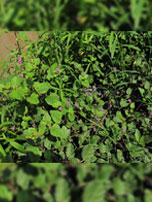SHAHEED KARTAR SINGH SARABHA AYURVEDIC MEDICAL COLLEGE & HOSPITAL
Affiliated to Guru Ravidas Ayurved University, Hoshiarpur Punjab
Affiliated to Guru Ravidas Ayurved University, Hoshiarpur Punjab

Botanical Name : Boerhavia diffusa Linn.
Family : Nyctaginaceae
Introduction :
This drug used as diuretic. It is also used as a Rasãyana. Some people says this plant is not punarnava it is varshabu, according to them punarnava and varshabu are different.
Names in different Indian languages :
English : Spreading Hog weed,pig weed
Bengali : Punanava
Panjabi : Itsit
Marathi : Ghetuli
Kanada : sandika
Malayalam : Thazhutama
Hindi : Sant,gadahpurna
Telugu : Attamamidi
Unani : Itsit,Bishkhaparaa
Sanskrit : Punarnava,sophaghni
Tamil : Mukaratte-Kirai
Synonyms :
Rakta-punarnavaa, Punarnavaa, Katthilla, Shophaghni, Shothaghni. Varshaabhu
Boerhavia repens Linn.
Boerhavia procumbens Roxb
Classification according to Charaka, Susrutha & Vagbhata :
Charaka
Vayahsthpana, Kasahara, Anuvusanopaga, Svedopaga
Susrutha
Susruta Vidarigandhadi
Vagbhata
Varieties & adulterants – (CV – controversy, AD – adulterants) :
1. Rakta – B. diffusa
2. Sveta Punarnavä – Trianthema portulacastrum
3. B. erecta – white coloured species
4. B.repens
5. T. monogyna
6. Boerhavia verticillata – substitute
Trianthema protulacastrum
Trianthema protulacastrum
B.repens
Morphology :
A perennial creeping herb with procumbent branches.
Root— stout, many procumbent , woody. Branches— diffuse.
Leaves— opposite, unequal pair,sub cordate, glabrous, .
Flowers— pale rose or white small or minute, borne in small umbels arranged in axillary and terminal panicles.
Fruits— 5-ribbed, spherical, glandular, 1-1.5 cm long.
Flowering and fruiting occur during winter.
Chemical Constituents :
xanthone, beta-ecdysone. arbinofuranoside, Hentriacontane, beta-sitosterol, oxalic acid. D-glucose, punarnavoside. punarnavine-I. punarnavine-2. boeravinones A, B, C etc.
Properties :
Rasa Madhura Tikta Kasäya
Guna Laghu, Rüksa
Virya Usna
Vipaka Katu
Karma : Kapha-vata hara, sothahara, tarpana, rasayana, balya, Dipana
Diuretic, anti-inflammatory, antiarthritic, spasmolytic, antibacterial, cardiac stimulant, laxative, expectorant, anti inflammatory, analgesic, expectorant, CNS depressant, abortifacient.
Indications :
sopha, Pandu, Visaroga, Raktapitta, Vriddhi, Udara, Hridroga, svãsa, mutrachrichra
inflammatory renal diseases, nephrotic syndrome,leucorrhoea, scabies, urinary tract infection, cough, constipation, myalgia, anaemia, bronchitis.
Part Used :
Whole plant, root, leaf.
Dosage :
Fresh juice 5-10 ml, powder 1-3 g.
External uses :
Punarnava is used for local application in the form of poultice or fomentation in edema. The juice of its leaves is used in the eyes for topical application.
Internal uses :
Digestive system : It is given internally in agnimandya, toxicity, ascites and constipation. A dose of 3 grains is used to induce vomiting.
Circulatory system : Useful in heart disease, anaemia, oedema. Leaves vegetable is consumed to reduce oedema.
respiratory system : Useful in cough, asthma and urahkshat.
Reproductive system : Menorrhagia, (root decoction of red variety is used). Seeds are, aphrodisiac. Eye diseases: Cataract, chronic conjunctivitis, blepharitis, (roots rubbed in honey is locally applied).
Urinary system : Acts as a diuretic in dysurea.
Skin : Useful in reducing swelling and foul smelling in skin disorders.
Temperature : Antipyretic, especially in quaternary fever.
Satmikaran : As a rasayan therapy in- general debility.
Antidote to snake poison and rat bite (used internally).
Important Yogas or Formations :
Punarnavadi Kvãtha, Punamavarista, Punarnavãdi mandura, Punãrnavadi taila, Punarnavã rasayana. Punarnavashtak, Punarnavasav
Important research work going on :
(1) cholesterol and blood sugar level
(2) haemostatic effect
(3) diuretic activity
(4) anti-inflammatory activity
(5) Cardio tonic effect
(6) fibrinolytic activity
(7) chronotropic effects
(8) hepatoprotective activity
(9) effect on calcium channel
Therapeutic Uses—
(1) Nidränãsa— Decoction of Punarnavã is very useful (H. S.).
(2) Sotha— Ghee prepared with the decoction and paste of Punarnava is given (C.D.).
(3) Alarka visa— sveta Punarnavã is given with Dhattüra fruits (A.S.Ut. 46)
(4) Plihodara— sveta punarnáva root is pounded with rice- water and given orally.
